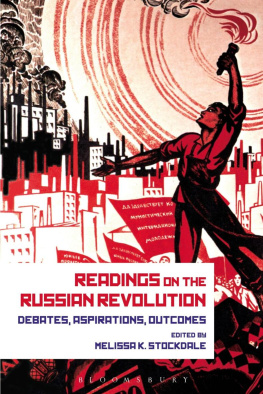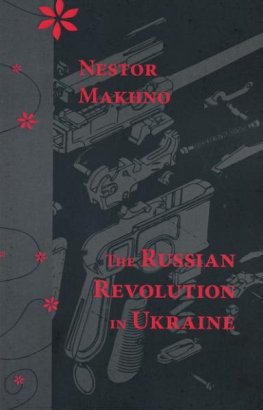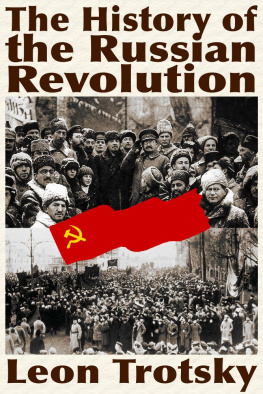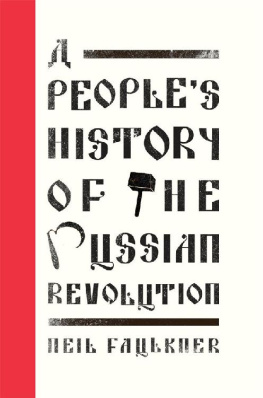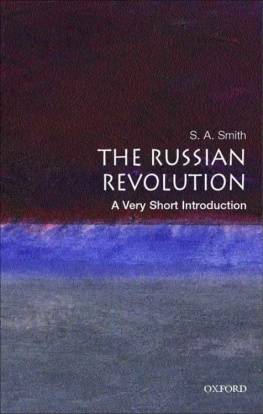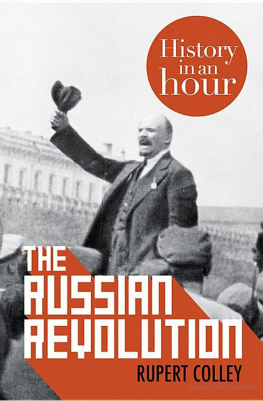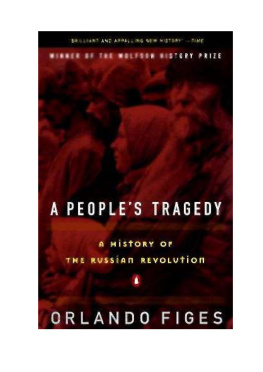Contents
1 Reflections on the Russian RevolutionRichard Pipes
From A Concise History of the Russian Revolution
3 Water Is Yours, Light Is Yours, the Land Is Yours, the Wood Is Yours
Sarah Badcock
From Politics and the People in Revolutionary Russia
4 Kerenskii: Popular Brand and Symbol of the Revolution
Boris I. Kolonitskii
From Tovarishch Kerenskii: Antimonarkhicheskaia revoliutsiia i
formirovanie kulta vozhdia naroda [Comrade Kerenskii: The
Anti-Monarchic Revolution and Formation of the Cult of the Leader of the People]
5 DecolonizationJoshua A. Sanborn
From Imperial Apocalypse: The Great War and the Destruction of the Russian Empire
6 Psychological ConsolidationPeter Holquist
From Making War, Forging Revolution: Russias Continuum of Crisis, 1914-1921
7 Social DisintegrationIgor Narskii
From Zhizn v katastrofe. Budni naseleniia Urala v 1917-1922 gg. [Life in Catastrophe: The Everyday Life of the Ural Population, 1917-1922]
8 Nationalizing the RevolutionAdeeb Khalid
From Making Uzbekistan: Nation, Empire, and Revolution in the Early USSR
9 Bolshevik Ritual Building in the 1920sRichard Stites
From Russia in the Era of NEP: Explorations in Soviet Society and Culture
10 ConnectingEmma Widdis
From Visions of a New Land: Soviet Film from the Revolution to the Second World War
11 Daily Life and Gender TransformationElizabeth A. Wood
From The Baba and the Comrade: Gender and Politics in Revolutionary Russia
12 Forging the Revolutionary SelfJochen Hellbeck
From Revolution on My Mind: Writing a Diary Under Stalin
13 Ending the RevolutionSheila Fitzpatrick
From The Russian Revolution
14 The Apotheosis of OctoberFred Corney
From Telling October. Memory and the Making of the Bolshevik Revolution
15 Communism and the New Forms of DictatorshipSteven G. Marks
From How Russia Shaped the Modern World
I am grateful for permission to reproduce in this volume excerpts from the following previously published texts: Reflections on the Russian Revolution, from A Concise History of The Russian Revolution by Richard Pipes, copyright 1995 by Richard Pipes, pp. 382400, 4026. Used by permission of Alfred A. Knopf, an imprint of the Knopf Doubleday Publishing Group, a division of Penguin Random House LLC. All rights reserved. Orlando Figes and Boris Kolonitskii, Languages of Citizenship, Languages of Class: Workers and the Social Order, from Interpreting the Russian Revolution. The Language and Symbols of 1917, copyright 1999 by Yale University, pp. 10410, 11226, by permission of Yale University Press. Emma Widdis, Visions of a New Land: Soviet Film from the Revolution to the Second World War, copyright 2003 by Yale University, pp. 2031, 3545, by permission of Yale University Press. Kerenskii: Popular Brand and Symbol of the Revolution, from Boris I. Kolonitskii, Tovarishch Kerenskii: antimonarkhicheskaia revoliutsiia i formirovanie kulta vozhdia naroda, mart-iiun 1917 goda, copyright 2017, pp. 46382, used by permission of the publisher, Novoe literaturnoe obozrenie. Revolution on My Mind: Writing a Diary Under Stalin , by Jochen Hellbeck, Cambridge, MA: Harvard University Press, copyright 2006 by the President and Fellows of Harvard College, pp. 114; Making War, Forging Revolution: Russias Continuum of Crisis, 1914-1921 , by Peter Holquist, Cambridge, MA: Harvard University Press, copyright@ 2002 by the President and Fellows of Harvard College, pp. 20613, 21722, 23136, 23940. The Russian Revolution, 3rd ed., by Sheila Fitzpatrick, copyright 2008: pp. 14963 and 16572, by permission of Oxford University Press. Imperial Apocalypse , by Joshua Sanborn, copyright 2014, pp. 21631, 2338, by permission of Oxford University Press and for material from this selection previously in Joshua Sanborn, The Genesis of Russian Warlordism, in The Journal of Contemporary History vol. 19, 3 (2010), pp. 2037, reprinted with permission of Cambridge University Press. Zhizn v katastrofe. Budni naseleniia Urala v 1917-1922 gg . [Life in Catastrophe. The Daily Existence of the Population of the Urals, 1917-1922], by Igor Narskii, copyright 2001, pp. 1224, 12832, 1359, 1616, used by permission of the publisher, ROSSPEN. Material reprinted from Nationalizing the Revolution, in Making Uzbekistan: Nation, Empire, and Revolution in the Early USSR, by Adeeb Khalid. Copyright @ 2015 by Cornell University, pp. 9095, 98102, 107112, 11316, used by permission of the publisher, Cornell University Press. Material reprinted from Telling October: Memory and the Making of the Russian Revolution , by Frederick C. Corney. Copyright @2004 by Cornell University, pp. 12, 47, 810, 7080, 903, used by permission of the publisher, Cornell University Press. Sarah Badcock, Politics and the People in Revolutionary Russia: A Provincial History , copyright 2007 by Cambridge University, pp. 1812, 184, 18690, 195201, 2036, 209, used by permission of Cambridge University Press. Richard Stites, Bolshevik Ritual Building in the 1920s, in Russia in the Era of NEP , Sheila Fitzpatrick, Alexander Rabinowitch, and Richard Stites, eds., copyright 1991, Indiana University Press, pp. 295309, reprinted with permission of Indiana University Press. Elizabeth Wood, The Baba and the Comrade: Gender and Politics in Revolutionary Russia , copyright 1995, pp. 194209, 21113, reprinted with permission of Indiana University Press; Steven G. Marks, Communism and the New Forms of Dictatorship, in How Russia Shaped the Modern World: from Art to Anti-Semitism, Ballet to Bolshevism , copyright 2002, Princeton University, pp. 299, 31015, 31921, 32532, reprinted with permission of Princeton University Press.
It is a pleasure to acknowledge the people and support that have contributed to this project. Much of my career has been devoted to study of the Russian Revolution and its causes; along the way, I have benefited enormously from discussions with and suggestions from many other specialists (only some of whose terrific work could be included in this reader.) These include colleagues at symposia and panels organized around the centenary of the Revolution: Peter Holquist, Boris Kolonitskii, Dominic Lieven, Eric Lohr, Yoshiro Ikeda, Rex Wade, Adele Lindenmeyr, Toshi Hasegawa, Rochelle Ruthchild, Dan Orlovsky, Alexander Rabinowitch, Vladimir Kalashnikov, Will Pomeranz, and Steve Norris. Particularly rewarding has been my work with fellow editors of and contributors to the international publishing project Russias Great War and Revolution, among them Tony Heywood, David McDonald, John Steinberg, Adele Lindenmeyr, Steve Marks, Murray Frame, Boris Kolonitskii, Karen Petrone, Aaron Retish, Choi Chatterjee, Eric Lohr, Chris Read, David Stone, Liudmila Novikova, and the late Mark von Hagen.
I would like to thank the five anonymous reviewers of the book proposal for their insightful comments, especially concerning which pieces to include in this volume. I am very grateful to Cathy Frierson and Steve Marks for their close reading of the introduction, and their help in keeping it within manageable length. Many thanks to Maria Whittle for her thoughtful translation of one of the Russian chapters. I have been privileged to work with the fine people at Bloomsbury Academic: Rhodri Mogford, my editor, whose enthusiasm and acumen are greatly appreciated; the thoroughly professional production managers, Laura Reeves and Rennie Alphonso; the copy-editor, Nikitha S. Nair; and the design department, who created the map and the handsome cover.

